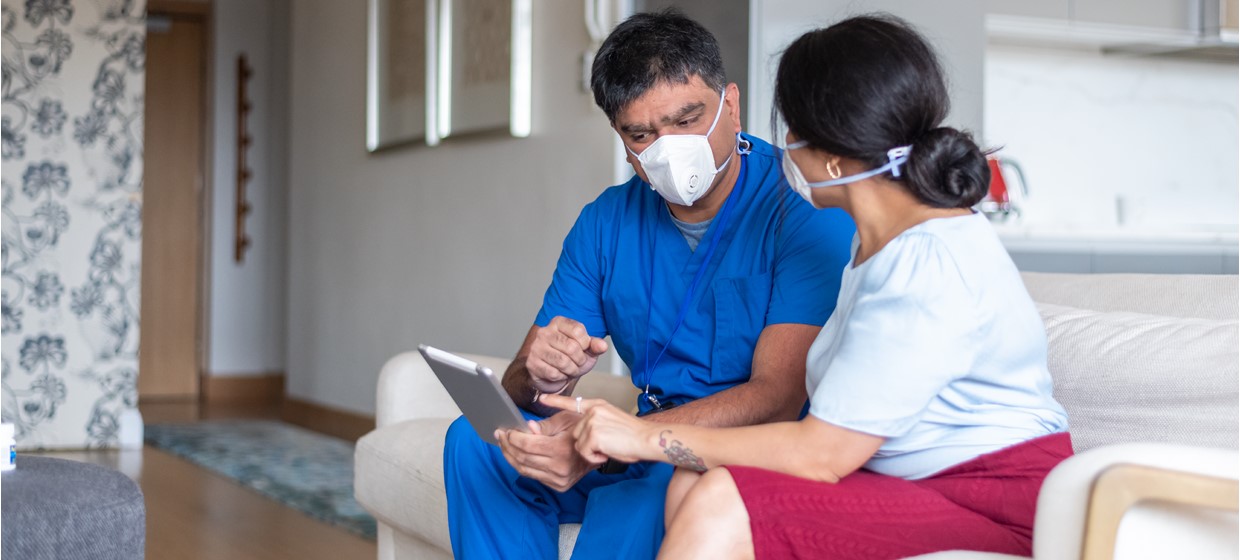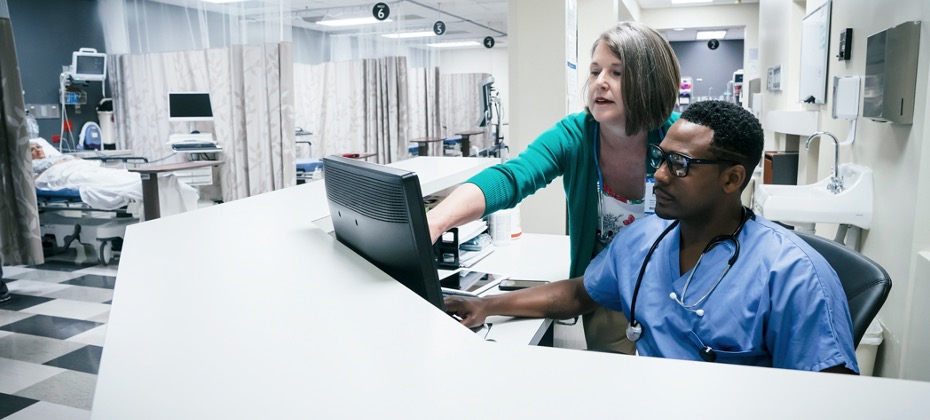Patient Access
Learn how to improve patient access by verifying critical patient information and collecting patient payments prior to service.

Earlier this year, Experian Health teamed up with PYMNTS to ask more than 2300 consumers about their digital healthcare habits. The results confirmed that consumers are eager to use digital channels, but still experience challenges in finding options that meet their expectations. The Digital Healthcare Gap: Streamlining the Patient Journey examines how healthcare providers currently use digital tools to allow patients to book appointments, obtain test results and make payments. It also examines how providers are closing gaps. This article summarizes the key insights that will help providers create a seamless digital experience and improve patient engagement. Download the report to get the full study, and to learn how healthcare providers are using digital channels to improve care and drive engagement. How are healthcare providers using digital channels to streamline access to care? While most patients still prefer to interact with healthcare providers in person or by phone, digital methods are increasingly popular. For example, Experian and PYMNTS data show that: 1 in 5 patients used digital channels to schedule appointments within the previous year. 1 in 3 patients used patient portals to fill out registration forms. 1 in 4 patients used digital methods to pay for healthcare. Urgent care patients were the most likely to schedule appointments online, with 17% using patient portals, 16% scheduling directly through practice websites and 5% booking by text message. Patient portals were also the most popular digital channel among patients booking appointments with family practices. These insights suggest that patients want on-demand patient access and a range of options to book, register and pay for care in a way that’s most convenient for them. When they have that choice, many opt for digital methods, though results vary by type of provider. Patient portals are emerging as the most popular channel because they allow patients to securely access and manage their healthcare information in one place, whenever and wherever they like. Missed us at the MUSE Inspire Conference? Contact us for more conversations about opening healthcare’s digital front door. How can providers better engage patients using digital healthcare solutions? Despite their enthusiasm, many patients run into challenges when using patient portals, especially when making payments. Obtaining accurate cost estimates before coming in for care was a major pain point for 15% of patients surveyed. Portals are an obvious solution, but only 24% of patients said they had access to portals that include this feature. Even among those patients with access to “estimate-enabled” portals, only 6% said they knew their out-of-pocket costs in advance, which may point to communication or usability issues. The ability to receive cost estimates in advance of treatment has a major impact on how satisfied patients feel with their overall care experience. Nearly 85% of patients said they were satisfied with their care, but those who did not receive cost estimates for their most recent appointments tended to be less satisfied. The portion of urgent care patients satisfied with their experience dropped to 74% when out-of-pocket expenses weren’t known in advance. Experian Health’s Patient Estimates can help address these gaps. This web-based pricing tool gives patients accurate cost estimates before their treatment and offers advice for financial assistance and charity options. Patient Financial Advisor complements this by delivering pre-service estimates of the patient’s responsibility straight to their mobile devices. With this solution, patients get a text message with a secure link to their cost estimates and payment options. Providers that offer a convenient and transparent financial experience through these types of digital tools are likely to see improved patient engagement and more efficient patient collections. Tom Cox, President of Experian Health, says that digitally-enabled convenience is the secret to better patient engagement. “Patients are consumers before they are patients. They may not be experts in medicine, but when it comes to convenient and efficient scheduling, registration, estimates, payments, communication, and flexible delivery of these services, the consumer becomes the de facto expert. Healthcare is quickly approaching the point where a standard of convenience and ease of use – primarily delivered via digital tools – will result in patient attrition for those failing to meet the standard. The ’innovation’ needed is to reach parity with the experiences consumers have in their other service interactions.” “Healthcare is quickly approaching the point where a standard of convenience and ease of use – primarily delivered via digital tools – will result in patient attrition for those failing to meet the standard.” - Tom Cox, President at Experian Health How can digital healthcare solutions attract and retain new patients? The research also found that opening the digital front door can supercharge efforts to attract new patients. 3 in 10 patients use digital methods to find and select providers, with 1 in 10 using online reviews as part of their search. Nearly 2 in 10 struggle to find the professionals they need. Building a consistent online presence can help increase providers’ “discoverability” and signal a commitment to digital healthcare that so many patients desire. Providers that offer easy and reliable digital tools are also going to be more likely to attract and retain new patients. With 20% of patients saying portals are complicated to use, and 13% saying they lack functionality, providers that offer streamlined digital services are going to be more attractive. Building on the existing momentum with online self-scheduling and self-service patient registration can make it easier for patients to choose and register with new providers. Cox recognizes that digital solutions are not a simple fix – but worth the effort. “As consumers, we take something like scheduling for granted. What goes on behind the scenes is pretty complicated, however. In the case of scheduling a medical visit, there are specific time slots, physician schedules, how to address cancellations and the need for referrals, among many other variables.... It can be challenging for a healthcare provider to aggregate disparate data into a digital tool that’s easy for patients to engage with. That’s why solution partners like Experian Health are critical to help deliver a better patient experience.” Find out more about how Experian Health’s tried and tested digital tools can help providers streamline the patient journey.

When it comes to patient access, friction can lead to bad patient experiences. If patients can’t see a quick way to schedule a medical appointment when they visit their provider’s website, they’ll click away. If registration involves sitting in a waiting room with piles of paperwork, they’ll be reluctant to attend. If patients are confused by complex billing processes, they’ll put it off until they have the time and energy to engage. A recent survey by PYMNTS and Experian Health found that 61% of patients would consider switching to a provider that eliminates these pain points in patient access and offers more streamlined patient access, for example, through a patient portal. Beyond consumer satisfaction, convenient and flexible patient access makes financial sense for providers. It can help reduce no-shows, enable better use of staff time and accelerate patient collections. It also paves the way for higher quality care. After all, if patients are deterred from attending appointments and/or thinking about switching providers, it’ll take much longer for them to receive their diagnosis and treatment. What does “convenient and flexible” mean in practice? It means deploying digital patient access software that allows patients to complete intake tasks at a time and place that suits them. Self-service scheduling, automated registration, and personalized outreach around billing all help to create a friction-free consumer experience – and a more consistent cash flow. Rethinking patient access with patient-friendly digital solutions Consumer feedback in the survey by PYMNTS and Experian Health suggests there’s an opportunity to rethink patient access to meet patients’ digital expectations. Here are some examples of revenue-boosting swaps that will help create a patient access and intake experience that keeps patients coming in: 1. Instead of time-consuming queues and call center bookings → offer convenient online self-scheduling Around a fifth of patients say they’ve used digital scheduling tools, including patient portals, websites or text messages. Patients want to be able to schedule appointments when it suits them, rather than having to call within fixed hours to speak to a call center agent. Online self-scheduling allows patients to quickly find and book available appointments. Some providers may worry that these systems can’t account for their complex scheduling rules, but that’s not the case. Built-in guided search functions can factor in the provider’s scheduling rules, so patients are only offered appointments with the right providers. It’s easier for patients, and it’s far more efficient for staff. Relying on institutional knowledge and thumbing through giant binders of questionnaires can be stressful, time-consuming and error-prone. Online patient scheduling platforms eliminate these challenges. 2. Instead of patchy patient data → get accurate and complete patient identities One of the biggest challenges in patient access is capturing and utilizing accurate patient information. Typos, missing demographic details, out-of-date contact information and duplicate data all contribute to gaps and errors in patient identities. Without complete and reliable patient records, providers run the risk of delivering substandard care and suffer from preventable revenue loss. Instead of relying on manual data input processes, providers need digital systems that ensure the information added to a patient’s record is correct and complete. Experian Health’s Patient Identity Management solution pulls from the industry’s most reliable data sources to verify each patient’s information. It arms staff with automatic updates and alerts them to any potential discrepancies. Identity Verification helps improve the patient experience, minimize payment delays, and protect patients and healthcare organizations from identity theft. With more accurate data, collections are more efficient, leading to faster revenue recovery and fewer costly denials. 3. Instead of losing revenue to unnecessary write-offs → run automated coverage checks to find forgotten insurance If patients are unsure of their insurance coverage status, providers must invest time and resources to check for missing coverage. This pain point is currently in sharp focus, with the end of the COVID-19 Uninsured Program and the end of continuous Medicaid enrollment. As patients’ coverage status changes, providers must be able to run efficient checks for any potential missing or undisclosed coverage. Experian Health’s Coverage Discovery tool can run automated checks to look for billable coverage, as soon as the patient first interacts with the organization. Data-driven coverage discovery gives patients clarity about what they owe so they can plan ahead and allows more efficient use of staff time. 4. Instead of opaque pricing information → make it easy for patients to understand and pay bills Patients want transparent healthcare pricing. However, 15% of patients said they found it difficult to get accurate price estimates before coming in for care. The complaint was more frequent among the most digitally active patients – who are also more likely to switch providers based on the quality of digital services. Despite a recent push toward price transparency, there’s still a long way to go, with many providers struggling to comply with new federal price transparency requirements. Upfront pricing estimates make it easier for patients to understand and plan for their medical bills. With Patient Payment Estimates, patients get a clear, personalized breakdown of their expected financial responsibility sent directly to their mobile device. Patient Financial Advisor takes this a step further, by offering a text-to-mobile financial experience that connects patients with estimates, payment plans and contactless payment methods. Providers that offer convenient and flexible ways to pay will be best placed to protect profits. Discover how Experian Health’s digital patient access software solutions can help attract and retain satisfied consumers and bolster the bottom line.

Healthcare’s digital transformation promises patients ever-growing choices in how to access, experience and pay for care. Providers know that opening their digital front door is the key to attracting and retaining loyal consumers. However, deciding on the exact technologies and services to offer can be challenging. A good place to start is to follow the patients’ lead: what digital tools do they say they want? How are they using existing services (or not)? By understanding patients’ attitudes and behaviors, providers can design a digital patient journey that leads to increased patient satisfaction. A new collaborative report by Experian Health and PYMNTS provides fresh insights to inform digital patient engagement strategies. This survey, conducted in January 2022, interviewed over 2000 patients to understand how they’re using digital methods to access healthcare services and their biggest pain points. The findings revealed a need for digital services that foster convenience and choice. Digital-savvy consumers expect user-friendly online options across the care continuum, from scheduling and registration to final payment. Improving these services is also likely to encourage the less digitally confident consumers to try alternative methods and increase access to care. This article offers a snapshot of the key findings that will help providers identify gaps in their digital offerings and build a digital experience that meets consumer expectations. Finding 1: Patients are looking for digital methods to perform most healthcare activities. Patient portals are the most popular method for obtaining test results, with 44% of patients choosing this option. A quarter of patients have used digital methods to pay their medical bills. Digital methods are widely used across the patient journey, from scheduling appointments to receiving test results. Patients expect convenience, flexibility and choices, with many reporting frustrations when they can’t access the digital services they desire. Providers that offer a broad selection of digital patient engagement solutions will be best placed to respond to changing consumer demands. Beyond patient satisfaction, digital tools facilitate better care plan adherence, improve workforce efficiency, and contribute to higher patient collections rates. Finding 2: Patients are satisfied with their healthcare experience but find it challenging to confirm costs and select new providers. 15% of patients report difficulties when obtaining accurate cost estimates for appointments and procedures. Predictably, digital-first patients have the highest expectations of digital systems. They are accustomed to convenient and accessible digital processes elsewhere in the consumer world. Healthcare organizations with an open digital front door will be more attractive to these potential new patients. Digital payments could be a worthwhile investment in this regard. A previous PYMNTS survey found that 63% of patients would consider switching providers if the payment experience wasn’t up to par. To improve the payment experience, providers should consider offering upfront pricing estimates to make it easier for patients to understand and plan for their bills. A tool such as Patient Financial Advisor can act as an online financial concierge for patients, by connecting them with appropriate payment plans and contactless payment methods directly through their mobile devices. Finding 3: Two-thirds of patients use patient portals, but many find portals lack essential payment features. While 62% of patients use portals, this rises to 82% among digital-first consumers and drops to 19% among non-digital consumers. 64% of patients say cost estimates are very or extremely important, but only 24% say they receive estimates. Closing the gap between what patients expect of portals and what’s actually delivered could help narrow the differences in portal usage between different patient groups. Credit and debit cards are currently the most popular payment methods, but patients would use them less often if their preferred digital payment methods were available. Providers should consider combining high-performing patient portals with a range of payment options. Finding 4: Frictionless patient portals could prevent patients from switching providers. 61% of patients say they would switch to a healthcare provider that offers a patient portal. Improving patient portal capabilities is likely to be an important driver in attracting new patients. However, it’s also essential to retain existing patients. More than six in ten patients say they’d switch to a provider that offers a patient portal. This number rises to nearly eight in ten younger patients. A digital-first experience is no longer simply a preference, but an expectation for many consumers. To better engage and retain consumers throughout the patient journey, providers must explore the use of patient portals and other digital solutions to remove digital pain points and meet consumer expectations for a frictionless patient access experience. Download the full report to learn how healthcare providers can relieve digital pain points to offer improved patient care and satisfaction.

Healthcare revenue cycle challenges exist at every stage of the patient journey, beginning with patient access and extending all the way through claims, billing, payment and collections. However, digital tools and analytics can help providers tackle their top healthcare revenue cycle challenges. “The complexity of our reimbursement structures and the complexity of billing mean a variety of aspects impact revenue cycle management,” says Tricia Ibrahim, Director, Product Management, Contract Manager, Hospital at Experian Health. “Technology, regulations, changing contractual obligations and payer policies, people, processes, billing—each of these complexities adds to the challenge.” Revenue cycle management (RCM) issues can also lead to revenue loss if not addressed. Data and analytics, digital tools and automation can help providers manage complexity and adapt to evolving patient needs. Here are seven of the top healthcare revenue cycle challenges and how providers are taking them on: 1. Problems with patient access Consumers accustomed to using mobile apps and online services to shop and do their banking look for seamless digital experiences when they’re choosing a provider, scheduling appointments and managing pre-appointment activities like registration and insurance verification. In a new consumer survey by Experian Health and PYMNTS, 77% of patients who were not currently using digital tools for healthcare said they would be interested in switching to a provider that offered a patient portal. The automated tools that make up your digital front door make a huge difference in how patients engage. Together with accurate estimates and convenient payment options, digitally focused Patient Access Solutions help providers enhance the patient journey and improve registration accuracy. Manual processes require more staff time up-front; human error can lead to claim denials or billing errors later in the cycle. Automating streamlines the process. Offering patient intake software that can be accessed online or via a mobile device provides the flexible and familiar digital experience they expect in today’s world. 2. Poor collections recovery rate As high deductible health plans have patients taking more responsibility for their healthcare costs, patients are finding it more difficult to pay. Bigger bills often translate into a greater potential for confusion, more questions about insurance coverage, and a greater need for financing options. Providers need effective collections strategies to boost revenue and lower bad debt write-offs as more focus shifts to the patient as a payer. A patient-centered payments strategy helps patients better understand their estimated costs, insurance coverage, and payment options. To help patients navigate the financial process successfully and navigate this healthcare revenue cycle challenge, providers will need to support them with: Clear, accurate estimates that show patients how much they’ll owe up-front Payment options that include multiple payment methods, including cards, Apple Pay, and e-checks Navigating payment plans to manage large balances A process that encourages payment before service or at the point of service to reduce collections down the line When providers have to collect, digital tools and analytics can help optimize the collections process by prioritizing accounts that are most likely to pay, automating billing and messaging workflows, and even tracking the effectiveness of outside collections agencies. 3. Billing errors Claim denials are a drag on workflow, sending staff into a repetitive loop of claims submission, denial, correction, and delay—and throwing a wrench into revenue flow. A denied claim typically slows reimbursement by 16 days. Worse, claim denials are on the rise: 69% of healthcare leaders in an MGMA Stat poll reported that denials increased at their organizations in 2021. Replacing manual processes with automated workflows can reduce billing errors and A/R days. Integrated claims management software reviews claims for inaccurate coding before claims are submitted, easing demands on staff time, reducing claims denials, and shortening the time between billing and payment. 4. Underpayments in payer contracts Missed payments and underpayments can add stress and volatility to your revenue cycle. Often, the source of these problems lies in payer contract issues. “Payers often know your book of business better than you do,” says Ibrahim. “When you’re negotiating contracts, you need to be able to go through large amounts of data quickly and efficiently, so you can come to the table armed with information. One of the services we provide is contract analysis to help providers evaluate contract terms in real dollars and cents.” For active contracts, Healthcare Contract Management helps providers track inaccurate payments and hold providers accountable. 5. Changes in healthcare regulatory and compliance standards New regulations are a constant in healthcare. However, this is one of the biggest healthcare revenue cycle challenges that providers need to keep up with. Failing to stay up to date with the ever-evolving compliance landscape can lead to claim denials, payment delays, and administrative and billing backlogs. Healthcare Regulatory Solutions, which includes systems for providing transparent, patient-friendly estimates, can make it easier to make regulatory compliance part of your regular business processes. A free No Surprises Act (NSA) Payer Alerts Portal keeps providers updated on how new NSA regulations are playing out. 6. Lack of data-driven metrics and insights Gaining efficiencies in RCM means using analytics to provide a big-picture view of what’s happening throughout the enterprise. This perspective is not always the default in a busy healthcare practice or hospital. Yet, “Fixing claim after claim on an individual basis isn’t going to get you the efficiency you want,” says Ibrahim. “You need to identify trends to find the biggest opportunities to improve your results.” Comprehensive data and analytics are key for providers that want to pinpoint and address areas of trouble. Here, disparate systems and siloed information can get in the way of creating the single view needed to diagnose the issues that are slowing down claims, billing, and payment. Revenue Cycle Management Analytics integrates client data with non-native standard Electronic Data Interchange sets to reveal opportunities for process improvements. By leveraging the right data, providers can optimize patient access productivity, billing efficiencies, reimbursements, and payer performance. 7. Potential security issues Patient portals engage patients and empower them to schedule their appointments, review test results, or make payments. But as providers digitalize to improve the patient experience and boost the revenue cycle, patient identities and data may be at greater risk. Cases of medical identity theft reported to the Federal Trade Commission rose more than 532% between 2017 and 2021. Medical identity data is particularly valuable to thieves, bringing 20 to 50 times more money than data from financial sources. Securely authenticating patients is critical as a safeguard for both providers and patients. Identity theft damages the patient experience and erodes trust, while dealing with the resource and reputational damage fraud can cause is a major potential liability for providers. Working with vendors that provide extensive Patient Portal Security and digital tools that protect patient identities without causing friction or frustration is essential to keeping patient data safe without alienating the patients in the process. Prevent healthcare revenue cycle challenges with automation Revenue cycle management healthcare challenges are among the great tests facing providers right now. But improvements in digital tools and analytics are helping providers keep revenue flowing while keeping both compliance and the patient experience in focus. Find out more about how Experian Health's Revenue Cycle Management Solutions can help your organization meet the challenges of modern RCM.

Patient experience may not be the first consideration that comes to mind when you're looking to improve revenue cycle management (RCM). However, a positive patient experience can benefit RCM. It can make the complicated process of understanding and managing healthcare finances simpler and more seamless for patients—and facilitate an easy-to-navigate continuum of care that includes RCM. Financial transparency plays a significant role in building trust and confidence between patient and provider. Patients who may find it difficult to understand medical billing and health insurance coverage—and who are paying more out-of-pocket costs thanks to high-deductible health plans—appreciate accurate estimates and a range of convenient payment options. By optimizing back-end claims, billing, payment and collections processes, providers free up staff to provide individualized help to patients who need it. Strategies to bolster patient experience and RCM Patients who have grown accustomed to using digital platforms for everything from online shopping to food delivery, travel, managing finances and entertainment gravitate toward digital tools and expect a high level of functionality. In a Salesforce survey of 15,000 consumers, 68% of respondents said their expectations of companies' digital capabilities increased after COVID-19 drove more of their activity online. Providing a superior digital experience is now synonymous with good service, but healthcare is lagging behind other service sectors. For providers, automation and data analytics can streamline workflows and improve efficiencies. These factors are critical as staff find themselves under increasing pressure to provide accurate patient estimates upfront and to submit claims accurately to reduce denials. How can providers use the patient experience to improve RCM? Here are a few areas of focus to consider: 1. Offer consumer-friendly front-end technology Patients are looking for seamless digital experiences, where they are empowered to search out what they want, choose from a menu of options and pay effortlessly online. In a healthcare setting, they want to find and schedule their own appointments quickly. Providing new and existing patients with 24/7 mobile access to online patient scheduling is critical to early engagement. In fact, a new report from Experian Health and PYMNTS revealed that 61% of patients interested in using patient portals say they would switch to a healthcare provider that has one. Providing patients with an accurate estimate they can review in advance improves transparency and builds trust. This allows patients to ask questions and make decisions about how to pay on their own time and without pressure. Pre-appointment estimates might also offer patients the opportunity to pay conveniently online before their appointments or at the point of service, minimizing the need for post-treatment collections and reducing RCM costs. 2. Simplify and automate in-office technology Automation can boost the experience on both sides of the front desk. Automated processes simplify patient-facing tasks like registration and check-in while making back-office operations like data entry and authorizations more efficient. “When a patient submits photos of their insurance card and identification, software scrapes that information and inputs it into the system,” Serie explains. “This process is more convenient for the patient, faster and more efficient for staff, and reduces the potential for human error.” As healthcare providers continue to experience staffing shortages, automated systems can offer greater workplace flexibility. That's helpful for providers that need to flex their resources, but also for employees who want more options on where and when they work. 3. Provide price transparency and financial information to improve the patient experience In a Policygenius consumer survey, 26% of respondents said they have avoided care or treatment because they were unsure what their insurance covers. Patients might be forgiven for feeling confused and frustrated – healthcare bills are not always patient-centric. In fact, many consumers report a low level of insurance literacy and, unless told, don't know in advance what medical procedures are likely to cost. At the same time, out-of-pocket costs are rising, raising the stakes and increasing the likelihood that medical bills will pose a significant financial challenge. Outlining estimated costs prior to service can help patients understand their expected out-of-pocket payments. Accurate patient payment estimates take away some of the sticker shock and give patients an opportunity to discuss coverage with their insurance companies, choose the right payment methods, or arrange for payment plans before treatment happens. 4. Allow for online bill payments Frictionless payments are now the norm, online and in-app. Experian Health's PatientSimple solution offers healthcare organizations a suite of tools to simplify payment. Using a healthcare-specific algorithm, PatientSimple provides personalized, data-driven insights that help providers deliver the right messaging and payment options, including: Price estimates based on insurance coverage and payer's negotiated rates Guest payment option for patients who don't want to set up an account Online payments and payment plans E-statements, online account access and email payment reminders Qualification for financial assistance A smoother path to payment increases the chances that patients will pay pre-appointment or at the point of service. By offering patients more and better payment options providers can increase up-front revenue and reduce the need for collections. 5. Enable self-service Frictionless payments are just one facet of helping patients help themselves. Enabling the tools that create a “digital front door”—including the ability for patients to register and check-in online, access a virtual waiting room and make “contactless” payments—can boost engagement and give patients greater choice, control and convenience. By mapping a patient journey that flows seamlessly between virtual and in-person interactions, providers can set the stage for receiving payment earlier in the process. This can also help with outreach to patients post-care for follow-up and payment, if necessary. 6. Ensure coding and billing accuracy Clear, accurate patient billing is the goal, but keeping up with changes across multiple payers is an ongoing challenge for healthcare providers. New products, mergers and acquisitions, policy and procedure changes all create the potential for errors, denials, delay and lost revenue. Experian Health's Payer Alerts helps notify providers of payer policy and procedural changes with a daily digest email and an online portal. A simplified estimate process with fewer revisions streamlines the RCM process; it also helps patients avoid confusion, which degrades the patient experience and may cause patients to delay payment. 7. Optimize bill collections Collections can be one of the most difficult parts of healthcare RCM. On the patient side, post-treatment collections feel like a hassle; they may also become a source of significant financial problems. For providers, collections can be costly and time-consuming. Optimizing collections with automation and data analytics can streamline the process and improve outcomes. Experian Health's Collections Optimization Manager uses specialized scoring algorithms to segment and prioritizes accounts based on the likelihood they'll be able to pay. Automated billing and outreach make collections less onerous for staff, while automatic updates keep accounts and communications current. For patients, providing convenient digital payment options takes some of the friction out of the payment experience and removes at least one barrier to bringing an account current. Patient experience and RCM go hand in hand Improving healthcare RCM is certainly not the only reason to work on improving the patient experience. Enhancing the patient journey across the care spectrum can help providers engage new and existing patients, offer the digital tools and seamless experiences they've come to expect, and reduce their anxieties over medical costs. At the same time, using RCM solutions to bolster the patient experience means new efficiencies for staff and, along with this, expanded opportunities for work flexibility and greater success at managing the revenue cycle. Contact Experian Health to learn more about optimizing your patient experience and improving RCM at your organization.

Experian Health and PYMNTS recently collaborated to release a new report, "Accessing Healthcare: Easing Digital Frictions In The Patient Journey." Getting care through digital channels became a norm during the pandemic, and will continue post-pandemic. Digital-savvy consumers have come to expect seamless experiences; however, there are a few gaps that healthcare providers must continue to address. This report examines how consumers use digital healthcare channels, their pain points and how providers can address gaps to improve patient care and satisfaction. Check out some of the highlights below: To learn more about how consumers access healthcare services via digital methods, download the full report.

According to a recent survey by PYMNTS, many patients want digital healthcare management tools. 76% of survey respondents said they were “very” or “extremely” interested in using at least one digital method to manage interactions with their healthcare providers, rising to 86% among younger patients. This finding echoes Experian Health’s research from our State of Patient Access 2.0 survey. In this survey, we found that the pandemic had cemented consumer expectations around convenient access to care. Providers that wait too long to open their digital front door risk losing consumers to competitors. The “digital front door” describes how a patient can find and access care through online and digital channels. This can include everything from booking appointments and virtual waiting rooms to contactless payments and telehealth. It’s more than just patient access: digital technology can create convenient and connected patient experiences throughout the entire patient journey. The goal is a patient experience that flows seamlessly between in-person interactions and virtual touchpoints, from finding care to post-visit follow-up. Experian Health’s clients revealed that many have embraced digital tools to deliver a patient experience that matches consumer expectations, driven in large part by the pandemic.* Some are planning to invest in their digital front door within the next year, while resource constraints are hampering others in moving forward. Healthcare providers in the early stages of digital transformation may be wondering where to start. Where should they focus limited resources for the biggest gains? The four opportunities that could offer the greatest return on investment are online scheduling, omnichannel communications, contactless payments and productivity-boosting automation. Help patients find and book appointments with easy online scheduling Last year’s State of Patient Access 2.0 survey found that nearly eight in ten consumers prefer to schedule their own appointments at any time, from any device. This trend is set to continue in 2022 and beyond. Many patients have been using online scheduling platforms to book COVID-19 vaccinations and tests, as well as to reschedule care that was delayed during the earlier months of the pandemic. Opening the digital front door with online scheduling offers patients the control, convenience and choice they desire. No-shows are less likely, which leads to higher physician productivity and satisfaction, greater efficiency, lower costs and better patient outcomes in the longer term. Communicate through patients’ preferred channels to boost engagement With the pandemic necessitating so many rules around daily activities, limits on how and when consumers communicate with their providers can feel even more restrictive. Many don’t want to be forced into phone calls at inconvenient times, especially when a simple text reminder or a quick check of their patient portal would do the job. Providers that allow consumers to customize their patient access experience and engage through their preferred channels will be rewarded with increased patient loyalty. Omnichannel solutions also help to build a consistent care experience. A digital process that looks and feels the same every time, regardless of which platform the patient uses, will make navigating the care process much easier. Additionally, patients will be more likely to schedule appointments and fill out forms in a timely manner on their own, which can alleviate staffing resource constraints. A digital front door can help with contactless payments One part of the healthcare experience that can be notoriously tricky to navigate is paying for care. PYMNTS found that 63% of patients would consider switching healthcare providers over a bad payment experience. Providers can make it easier for patients to pay by offering upfront estimates of what the patient’s portion of the bill is likely to be, running automated coverage checks to make sure no insurance is missed, and sending automated reminders with links to contactless payment methods. According to PYMNTS, less than 20% of patients pay for care before or during their visit. However, if providers made it easier to pay, this percentage would likely shoot up. By offering patients their own mobile financial advisor, they can pay bills and access appropriate payment plans right from their phones. It’s convenient for patients and could help reduce delayed payments. A digital front door can improve patient access and relieve pressure on staff A digital front door doesn’t just open up opportunities for patients; it can increase efficiency and improve staff workflows. Healthcare staffing shortages have put immense pressure on providers to find new ways to automate repetitive tasks and relieve staff burnout while maintaining high-quality patient care. For example, automated scheduling algorithms can optimize patient flow and anticipate bottlenecks, so staff can allocate resources more efficiently. Registration forms that are pre-filled with a patient’s information are less prone to errors, compared to manual processes. Automation helps link the digital front door to the front and back offices, which can speed up workflows, support better care coordination, and create a more consistent patient experience. A high-quality digital patient experience should be built on consumer choice, control and convenience. A digital front door is more than just adding a few online tools or sending some well-timed automated texts; it should be at the heart of the entire patient engagement strategy. By investing in digital solutions that leverage the technology already used by patients and staff, providers can offer a stand-out patient experience and improve collections performance. Contact Experian Health today to find out how digital health solutions can help your organization deliver the best patient experience possible. *Survey of Experian Health clients, October 2021 Are you an Experian Health client? Then we invite you to join our Innovation Studio research community. Your ongoing input is key to driving improvements to our tools and products! Sign up here!

The recent discovery of the Omicron variant has placed the world on high alert. As COVID-19 continues to transform and evolve, erupting as “new” pandemics within the existing pandemic, it is becoming clear that digitally-enabled clinical care and access to that care are some of the world’s tools to mitigate its spread. Should infection rates rise, providers can anticipate fluctuations in patient volumes, which may trigger a return to the scheduling complexities seen earlier in the pandemic. Streamlining patient access with digital scheduling to minimize wait times, free up hospital beds, and ensure efficient intake workflows is going to be crucial. New variants could also exacerbate existing healthcare staffing shortages, which is a major concern for providers whose capacity is already at a “tipping point.” With a winter flu season “twindemic” looming on the horizon, and more people traveling over the holidays, this challenge may only get tougher. One route through this uncertainty is to continue the digital pivot seen in the early days of the pandemic. Here, we look at how flexible self-scheduling tools and other digital services can continue to help providers maintain operational efficiency as they navigate the implications of this new coronavirus strain. Uncertainty about Omicron – and future variants – could trigger patient scheduling complexities The new variant could trigger a rise in patient numbers, as seen with the Delta variant. In parallel, some providers and states may follow New York’s lead to try to manage non-urgent care and postpone certain elective treatments. Patients, too, may decide to hold off on booking appointments if they’re worried about contracting the virus while visiting their doctor. This means that the scheduling (and rescheduling) challenges seen throughout the pandemic could resurface. Providers should be ready to offer easy and convenient self-scheduling options. Digital patient scheduling platforms allow patients to book essential care and reschedule deferred appointments from the comfort of their own home, using whatever channel suits them best. Not only will this ease pressure on busy staff and reduce the number of people sitting side-by-side in doctors’ waiting rooms, but it’s also a quicker and more reliable way for patients to plan their care. Providers can augment these operational efficiencies with digital scheduling and registration tools. Registration Accelerator can reduce the burden on patient access teams by allowing patients to create user profiles and fill out pre-treatment information from home. Double down on convenient vaccination scheduling New variant outbreaks also add a layer of urgency and complexity to the ongoing vaccination program. Boosting the country’s vaccination rates is a crucial defense against existing strains of COVID-19. Patient-friendly digital scheduling tools can make it as easy as possible for people to arrange an appointment, thus helping to bump up vaccination rates. Of course, if more people are encouraged to seek vaccinations and boosters, the scheduling process could get even more complicated. Again, digital self-scheduling tools can ease the pressure, by using real-time databases and automation to ensure that patients book appointments within the requisite vaccination window. Automation can also be used to deliver personalized patient outreach reminders, nudging patients to schedule their vaccine appointment if they haven’t made one already. Comprehensive consumer data can help identify the most appropriate messages and channels for different patients, to make it as easy as possible for them to plan and book their appointment. The federal response to new outbreaks has included provisions for vaccine outreach campaigns and education initiatives. Providers should consider how their own outreach campaigns are performing, as well as ensure that their scheduling platforms are ready to meet the increase in demand that’s likely to follow. Automation and digital scheduling tools could help alleviate staffing shortages Behind the scenes, providers are still wrangling with ongoing staffing shortages. According to an analysis of US Bureau of Labor Statistics data, hospital employment declined by nearly 100,000 between February 2020 and September 2021, amounting to a financial cost of around $24 billion. New variants could make this worse. If more staff are infected, healthcare organizations may find it more difficult to handle the increase in patient volume. Automating manual tasks can free up capacity by helping to manage the growing demand for services and reduce call volumes. These automated tools and systems are designed to be user-friendly for busy staff, and for patients looking for a stress-free patient access experience. With streamlined self-scheduling options and more efficient staff workflows, providers can feel more prepared in the face of uncertainty. Contact Experian Health to find out more about how digital scheduling tools can help your organization prepare as the Omicron situation unfolds.

Healthcare providers could be losing up to $265 billion each year on avoidable administration costs. A recent investigation by the Washington Post and McKinsey & Company found expensive inefficiencies in several areas of healthcare expenditure, with financial transactions such as prior authorizations among the main culprits. How can healthcare organizations adjust to streamlining prior authorizations? Prior authorizations (or pre-authorizations) are intended to provide financial certainty to patients and providers, by confirming in advance that a payer will cover the cost of a particular test or treatment. However, securing pre-approval isn’t always a tidy process. The criteria are complicated and frequently change. In April this year, the American Medical Association reported that 85% of physicians found the burden associated with prior authorizations to be very high. The consequences are severe – hold-ups and errors can lead to delayed care, poorer outcomes for patients, and more unnecessary costs for providers. Securing pre-authorizations has always been challenging, but as with many healthcare operations, the COVID-19 pandemic exacerbated the problem. Experian Health’s State of Patient Access 2.0 survey revealed that more than half of providers find it difficult to keep track of changing pre-authorization requirements. Two-thirds expect to encounter roadblocks when seeking authorizations for rescheduled elective procedures. In fact, prior authorizations have overtaken patient payments as the biggest area of concern when it comes to collections and reimbursements. In our "Interview with the Expert,” Ellie Henry, Experian Health’s VP of Implementation, discusses the challenges around pre-authorizations and offers some immediate actions healthcare providers can take in response. Watch the interview below: Why are providers increasingly concerned about pre-authorizations? Pre-authorizations have been a hot topic for a while, but Experian Health’s State of Patient Access surveys, taken six months apart in November 2020 and June 2021, show a significant increase in provider concerns. Is this purely down to the “pandemic effect,” or is there more to it? Henry suggests that while the pandemic has been the main driver of recent authorization challenges, manual processes and changing payer rules have played a major role, too: “Hospitals had to restructure operations during the pandemic, which led to a lot of care being rescheduled. But it wasn’t always clear if existing authorizations would apply to that rescheduled care, which led to more reworking. Payers were continuing to adjust their rules, and understaffed organizations had to do more with less, which made it even harder to function effectively.” Many states also released their own pre-authorization requirements. For example, in September 2021, New York released an executive order to suspend prior authorizations for 30 days. While this may have been intended to ease pressure on staff and accelerate patient care, it also raised numerous questions. Providers had to determine if preapproval was needed for care that was planned during these 30 days or deferred until later and whether these changes overruled national payers’ requirements. How should providers address current pre-authorizations challenges? Henry says that providers can mitigate these challenges and focus on streamlining prior authorizations by dedicating limited resources to the most important problems first. This means using technology and automation to alleviate pressures on staff: “Providers need to streamline hand-offs and eliminate accounts that don’t need to be touched. With the right automation and technology, you can eliminate manual work and optimize workflows to manage demand. No matter how good you are, there’s always room to improve.” The growing administrative burden, exacerbated by increasing patient volumes, is an uncomfortable equation for healthcare organizations with reduced workforces. The traditional methods for managing patient accounts and checking for changes in payer policies are no longer sufficient. Instead, providers should look to automated prior authorization solutions that can ease the strain and ensure that more accounts are processed faster and more accurately. These should encompass both back-end automation and patient-facing digital tools that support self-service and reduce call volumes. What new opportunities lie ahead for streamlining prior authorizations? In the longer term, patient volumes will continue to increase as rescheduled care ramps up, and as patients begin to think about healthcare “maintenance” again. Providers have several options available to them to manage the pre-authorizations that will follow suit. Henry suggests that a good starting point is to invest in the right technology: “Technology can reduce manual tasks and keep the process manageable. The more tasks you can streamline and automatically update within your system, the better. Reach out to technology vendors and ask if their tools can help to make the process more efficient.” With prior authorization software, payer rules can be automatically updated so staff always know they’re looking at the latest information and don’t need to input data by hand. For example, Experian Health’s SmartAgent feature can sign the user into the appropriate payer website and auto-fill relevant patient information, saving time and reducing the risk of error. Dynamic work queues can help staff navigate the process with confidence and reconcile all the relevant data points within each patient’s specific situation. Henry also recommends doing knowledge-based checks to determine whether a patient’s planned procedure needs pre-authorization. Having records and supporting documentation in place can help handle rework and prevent errors from occurring in the first place. Engaging with payers to build stronger relationships is another strategy to support smoother authorizations. Again, reliable solutions and digital tools can simplify each of these tasks. Watch the full interview and download the State of Patient Access 2.0 white paper to find out more about how automation and digital tools can ease the burden and help with streamlining prior authorizations. By streamlining prior authorizations, providers can reduce unnecessary costs and deliver faster, high-quality care to patients.
